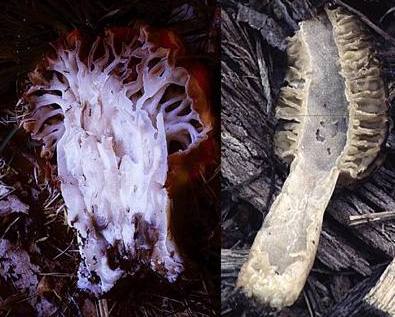Facts
Morchella esculenta is one of the most desired fungi for consumption. Every spring humans will set out to hunt M. esculenta to make some very tasty meals. Morels are relatively easy to pick out, and are easy to hunt because most of the mushrooms that look like morels are different species of the Genus Morchella and are also edible. There is one exception, however, that looks like the common morel but is extremely dangerous. This mushroom goes by the common name of the false morel. The false morel, or Gyromitra esculenta, looks like the common morel to the untrained eye. The difference between the common and false morel is that the stipe, or stem, of the mushroom is not hollow in the false morel. That is why when cooking morels, it is always smart to cut it in half lengthwise to assure that the stipe is indeed hollow and that an extremely poisonous mushroom is not being cooked.
 Because
morels are such a desired ingredient for cooking, they are also
a hot topic when it comes to learning how to grow morels
artificially out of season. A good way to grow them has yet to
be found, but during the morel growing season, M. esculenta is
being sold for $15-$20 per pound. Many people have tried to find
a way to continuously have success growing these morels, but in
reality, the growth of the fruiting body is by luck. The fungus
must have the proper amount of nutrients, water, the right
temperature, as well as having weather that isn’t too harsh on
the fungus. There are methods to take in order to have a
higher chance for the mushrooms to grow, but even then there is
no guaranteed success. The most prominent time for morels to
grow is after a forest fire. After a forest fire, the fungus
will grow in the sclerotia stage until the next forest fire,
which may not be for another century or so (Leonard 1992).
Because
morels are such a desired ingredient for cooking, they are also
a hot topic when it comes to learning how to grow morels
artificially out of season. A good way to grow them has yet to
be found, but during the morel growing season, M. esculenta is
being sold for $15-$20 per pound. Many people have tried to find
a way to continuously have success growing these morels, but in
reality, the growth of the fruiting body is by luck. The fungus
must have the proper amount of nutrients, water, the right
temperature, as well as having weather that isn’t too harsh on
the fungus. There are methods to take in order to have a
higher chance for the mushrooms to grow, but even then there is
no guaranteed success. The most prominent time for morels to
grow is after a forest fire. After a forest fire, the fungus
will grow in the sclerotia stage until the next forest fire,
which may not be for another century or so (Leonard 1992).
Morels are a
very common fungus used for culinary purposes. One recipe that
uses morels is a morel mushroom, rice, and chicken hot dish. It
is very common in the Midwest due to the popularity of morels.
Here is the recipe for this dish (Allen, 2013):
Ingredients:
· 1 ounce dried
morel mushrooms (or substitute other dried mushrooms)
·
4 tablespoons Butter
· 1 cup finely
chopped onion
· 1⁄4 cup flour
·
1 1⁄2 cups chicken stock
· 1 cup Heavy
Cream
· salt &
pepper to taste
·
2-3 cups Organic Prairie Chicken Breast, cooked, cut into chunks
· 4 cups wild
rice, cooked, than measured
·
2 tablespoons chopped fresh parsley
·
1 tablespoon chopped fresh thyme
·
3-4 tablespoons Organic Valley Shredded Parmesan (optional)
Directions:
1. Place mushrooms in a bowl and pour boiling water over them.
Push the mushrooms under the water and let them soak until they
have softened, 2-3 minutes. Drain, rinse mushrooms well with
cool water, and chop them coarsely.
2. Heat butter in a saucepan over medium flame. Add onions and
cook, stirring often, until they begin to soften, about 3
minutes. Stir in chopped mushrooms and continue to cook,
stirring often, until onions are translucent, another 4-6
minutes. Reduce heat to low, sprinkle flour over the vegetables,
stir well, and cook mixture, stirring often, 4-5 minutes.
3. Meanwhile, combine chicken stock and cream in a non-metal
bowl; microwave until hot, 2-3 minutes. Stir the stock mixture
into the vegetables, bring to simmer, and cook, stirring
occasionally as mixture thickens, 8-10 minutes. Season to taste
with salt and pepper
4. Combine vegetable mixture with chicken, wild rice, parsley
and thyme. Add more salt and pepper, if needed. Spread mixture
in a buttered casserole dish. It can be covered and refrigerated
at this point or baked immediately.
5. Bake at 350 degrees until heated through, 35-45 minutes. If
you’re using Parmesan, sprinkle it over the hot dish after the
first 20 minutes of baking time. Serve piping hot.
To finish your journey, check out References or Contact Me!
For more interesting websites on other organisms, visit MultipleOrganisms.net
Some other interesting fungi to check out....
Psilocybe cubensis, Trametes versicolor, Auricularia aricular-judae, and Schizophyllum commune!
